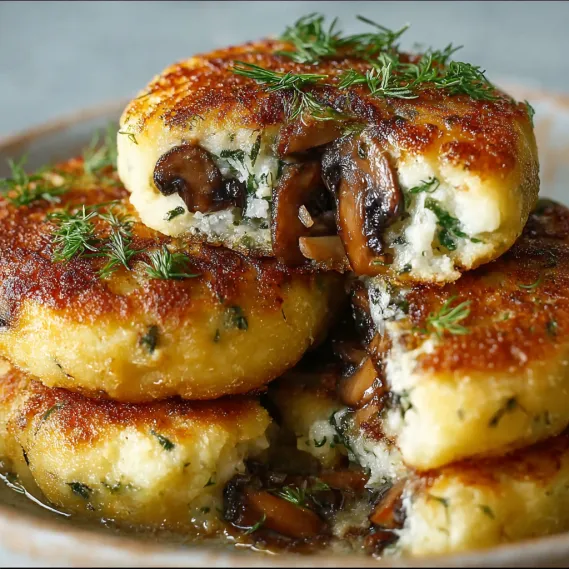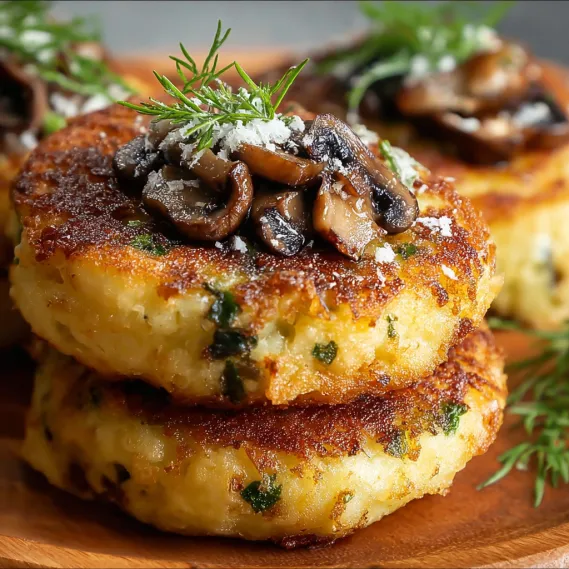 Pin
Pin
This hearty mushroom stuffed potato cake recipe transforms simple pantry ingredients into a delightful meal that's both comforting and impressive. The golden-crisp exterior gives way to a savory mushroom filling that will have everyone asking for seconds.
I discovered this recipe during a particularly rainy weekend when I was craving something comforting but elevated. My family now requests these potato cakes regularly, especially when mushrooms are in season at our local farmers market.
Ingredients
- Mashed potatoes: Use cold leftover mashed potatoes for best results as they hold shape better
- Mushrooms: Select cremini or button mushrooms for their meaty texture and earthy flavor
- Onion: Yellow or white onions work best providing sweetness when sautéed
- Butter: Unsalted is preferred so you can control the seasoning level
- Mozzarella cheese: Adds a lovely gooey center but can be omitted for dairy free version
- Flour: All purpose flour helps bind the potato mixture
- Egg: Acts as the crucial binder that holds everything together
- Salt and pepper: Kosher salt and freshly ground pepper make all the difference
- Fresh parsley: Brightens the earthy mushroom flavor with herbaceous notes
- Breadcrumbs: Panko creates the crispiest exterior but regular breadcrumbs work too
- Oil for frying: Vegetable or canola oil with high smoke point works best
Step-by-Step Instructions
- Prepare the Mushroom Filling:
- Begin by finely chopping mushrooms and onion to ensure they cook evenly and integrate well into the filling. Heat a skillet over medium heat and add butter until it melts and begins to foam slightly. Add the onions first and cook for 2 minutes until translucent before adding mushrooms. Cook the mixture for 5 to 7 minutes until mushrooms release their moisture and it mostly evaporates. Season generously with salt and freshly ground pepper and finish with chopped parsley. Transfer to a plate and allow to cool completely before using.
- Create the Potato Mixture:
- In a large mixing bowl combine cold mashed potatoes with flour egg salt and pepper. Mix thoroughly but gently until everything is incorporated. The mixture should be stiff enough to hold its shape when formed into a ball but not dry. If too wet add a tablespoon more flour if too dry a splash of milk.
- Form the Potato Cakes:
- With slightly damp hands take about 3 tablespoons of the potato mixture and flatten it into a disc about 3 inches wide and ¼ inch thick in your palm. Place a tablespoon of the cooled mushroom filling in the center of the disc along with a pinch of shredded cheese if using. Take another portion of potato mixture form it into a similar disc and place on top of the filling. Pinch and seal the edges together then gently shape into a round cake about ½ inch thick. Repeat with remaining ingredients.
- Coat and Prepare for Frying:
- Set up a plate with breadcrumbs. Gently press each potato cake into the breadcrumbs ensuring both sides and edges are coated evenly. Set aside on a clean plate while you finish coating all cakes. Heat a large skillet over medium heat and add enough oil to cover the bottom with about ¼ inch of oil.
- Fry to Golden Perfection:
- Once the oil is hot but not smoking carefully add the potato cakes leaving enough space between them to easily flip. Cook for 3 to 4 minutes on each side until deeply golden brown and crispy. Work in batches rather than overcrowding the pan. Transfer finished cakes to a paper towel lined plate to absorb excess oil.

The secret to these potato cakes lies in the mushroom preparation. I discovered that cooking the mushrooms until almost all moisture evaporates concentrates their flavor dramatically. My grandmother taught me this technique years ago, and it transforms even the most basic button mushrooms into something incredibly savory and complex.
Storage and Reheating
These potato cakes maintain their delicious flavor for up to 3 days when stored in an airtight container in the refrigerator. To reheat, place them on a baking sheet in a 350°F oven for about 10 minutes until heated through and crispy again. Avoid microwaving as this will make them soggy and lose their appealing texture.
Creative Variations
The basic recipe serves as an excellent template for endless variations. Try adding roasted red peppers and feta for a Mediterranean twist, or incorporate corn and jalapeños for a Southwestern version. You can also substitute sweet potatoes for regular potatoes, though you may need to add a bit more flour as sweet potatoes contain more moisture.
Serving Suggestions
While delicious on their own, these potato cakes reach new heights when paired with complementary toppings. Serve with a dollop of sour cream sprinkled with chives, a simple herb yogurt sauce, or even a poached egg for a satisfying breakfast option. They pair beautifully with a crisp green salad dressed with a bright vinaigrette to balance the richness of the cakes.
Historical Context
Stuffed potato cakes have roots in Eastern European cuisine, particularly in countries like Poland, Ukraine, and Russia, where potatoes have long been a staple food. Traditionally, these cultures would use potato cakes as a clever way to repurpose leftover mashed potatoes and stretch ingredients during leaner times. This recipe honors that practical cooking tradition while incorporating modern flavors.
Common Questions About This Recipe
- → How can I keep potato cakes from falling apart?
Use cold mashed potatoes and add flour or an egg to help bind the mixture, making it easier to shape and fry.
- → Can these be baked instead of fried?
Yes, you can bake the cakes at 400°F (200°C) until crisp and golden to create a lighter version.
- → What cheese works best in the filling?
Mozzarella is great for melting, but you can also use cheddar, Swiss, or your preferred cheese.
- → Can I make them ahead of time?
Shape and fill the patties in advance, refrigerate, and cook when ready to serve for best texture and freshness.
- → What’s a good dipping sauce for these?
Sour cream, yogurt, or a tangy lemon-based dip pairs well and enhances the savory flavor of the cakes.
- → Are there gluten-free options?
Substitute regular flour and breadcrumbs with gluten-free versions to accommodate dietary needs.
